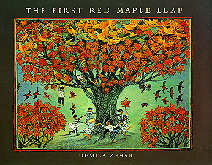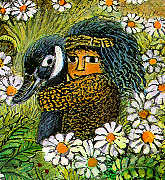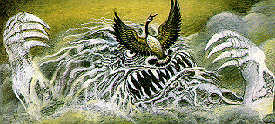


|
The First Red Maple Leaf.
Ludmila Zeman.
Subject Headings:
Preschool - grade 3 / Ages 4 - 8.
** /4
|

excerpt:
Iceheart followed the people south in silent rage, and when they felt his frozen breath, the people hid among the trees. Iceheart tore at the trees with claw and fang, but the trees stood firm and sheltered the people. The red leaves fell so thickly that Iceheart was blinded and turned away.
 A native of Western Canada, I shared author Ludmila Zeman's excitement at
seeing maple trees when I first visited Ontario. Since red maples do not
grow well in Manitoba, the sight of so many of them was something of a
revelation. With a new found sense of one of Canada's most identifying
symbols, I looked forward to reading The First Red Maple Leaf with great
anticipation. Unfortunately, the experience was disappointing.
A native of Western Canada, I shared author Ludmila Zeman's excitement at
seeing maple trees when I first visited Ontario. Since red maples do not
grow well in Manitoba, the sight of so many of them was something of a
revelation. With a new found sense of one of Canada's most identifying
symbols, I looked forward to reading The First Red Maple Leaf with great
anticipation. Unfortunately, the experience was disappointing.
The story begins with a land that is ruled by winter, the cruel and
terrible Iceheart. The people of the land are rescued from Iceheart after
a young boy befriends the goose, Branta, who then leads everyone to the
trees of the south and safety. Iceheart follows and shakes all the red
leaves from the trees. Once more the boy sets off, this time to find help
for the trees. With Branta's aid he returns with the birds of summer.
The colourful birds become the new leaves, and the people are given
the promise that, ever after, summer will always follow winter.

Ludmila Zeman received the 1995 Governor General's Literary Award for Illustration in Children's Books for The Last Quest of Gilgamesh, and The First Red Maple Leaf garnered a nomination for the same award for 1997. Particularly striking are the drawings of leaves surrounding the text and the final image of a cardinal undergoing a transformation into a maple leaf. Opposite each page of text is a full page illustration, sometimes consisting of several panels. While it may have seemed clear to the author in what order the images should be read, they are not well sequenced, and the reader is left in some confusion as to whether they should be read vertically or horizontally.
The weakness of the visual telling of the narrative is echoed in the text itself. Aspects of the story remain unexplained. For instance, why do the people not accompany Branta the goose on her trip further south and escape the wrath of Iceheart entirely? For that matter, Branta is described as a "grey goose," but she is quite clearly depicted as a Canadian goose with brown and black markings. Although the title is The First Red Maple Leaf the red leaves are shown as being present before Iceheart blows them from the trees. Of the birds that identically replace the leaves at the story's conclusion, no one bird is singled out as being the first.
Both the first and last pages of the book bear a message from the author, an immigrant to Canada, concerning her feelings for the maple leaf and her reasons for writing the story. This book is a very earnest attempt to express patriotism and love of a new country. While I share the emotions engendered by the maple leaf, they are not enough for me to encourage the purchase of this book.
Not recommended.
Tracey Keryluk is a member of the CM Board and manages the World Wide Web site for the University of Manitoba. As a librarian, she has a keen interest in young adult and children's literature.

To comment on this title or this review, send mail to cm@umanitoba.ca.
Copyright © 1998 the Manitoba Library Association. Reproduction for personal use is permitted only if this copyright notice is maintained. Any other reproduction is prohibited without permission.
Published by
The Manitoba Library Association
ISSN 1201-9364
TABLE OF CONTENTS FOR THIS ISSUE - FEBRUARY 27, 1997.
AUTHORS | TITLES | MEDIA REVIEWS | BACK ISSUES | SEARCH | ORDER | CMARCHIVE | HOME